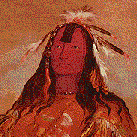
In 1870, Mark Twain published The Noble Red Man, a biting satire mocking Cooper's Indian characterization. Throughout the first part of the essay, Twain explores the Cooperian idealized characteristics; in the second half he replaces the idealized characteristics with degrading, demonizing ones. For example, Twain manipulates the Indian who is "tall, muscular, straight and of kingly presence" to be an Indian who is "little, and scrawny, and black, and dirty."
Besides criticizing Cooper's alleged unrealistic characterization, Twain attacks Cooper's ideology concerning American Indians that emerge in his texts. In Last of the Mohicans, Cooper frequently equates Indians with nature; Twain inverts this in the following mocking paragraph:
Still, when contact with the white man has given to the Noble Son of the Forest certain cloudy impression of civilization, and aspirations after a nobler life, he presently appears in public with one boot on and one shoe--shirtless, and wearing ripped and patched and buttonless pants which he holds up with his left hand--his execrable rabbit-skin robe flowing from his shoulder....
The Noble Red Man is a biting essay which would be easy to dismiss as either an example of racist rhetoric, or a satire exaggerated to such hyperbolic lengths as Jonathon Swift's A Modest Proposal. However, it cannot be safely filed into either of these categories. Its tone is ambivalent, and while the narrator does assert that Indians are dirty, lying, thieving beggars, we as readers are unsure if we are to take him seriously, or accept his rhetoric as frustrated resistance against unrealistic narratives modeled in the Romantic fashion.
 Read The Noble Red Man
Read The Noble Red Man